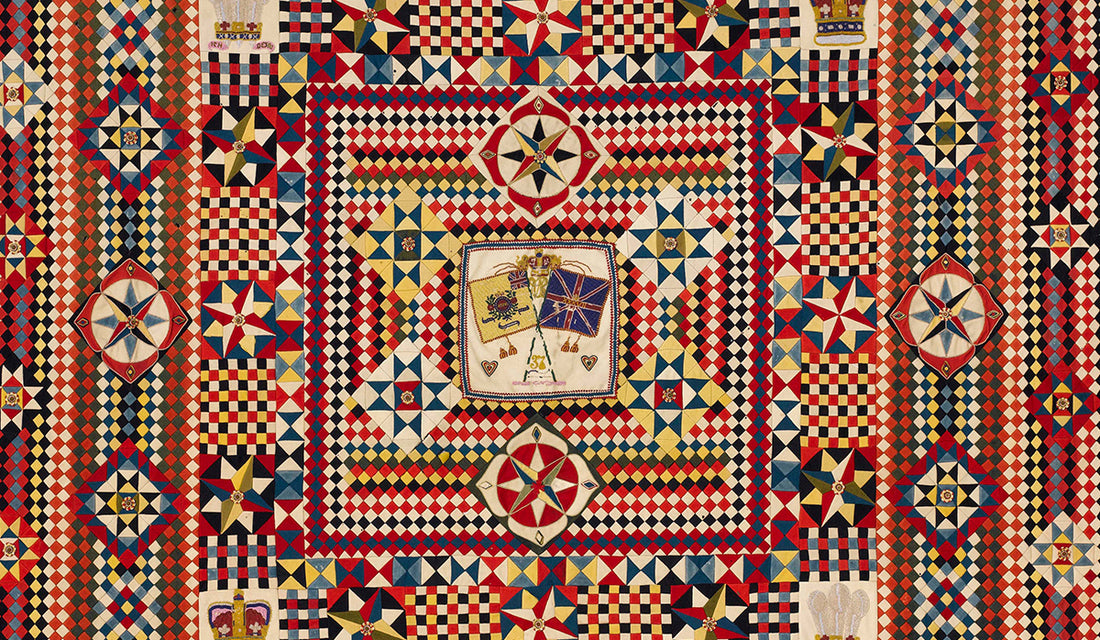
REGIMENTAL COLOURS
 Image: A soldier's patchwork with incredible border, c1855 – pre 1881 – Indian or English, felted wool taken from uniforms handsewn hand applied bead work, textures layered applique border 208 x 216 cm
Image: A soldier's patchwork with incredible border, c1855 – pre 1881 – Indian or English, felted wool taken from uniforms handsewn hand applied bead work, textures layered applique border 208 x 216 cm
A group of patchwork textiles have recently been rediscovered, all made during the 18th and 19th century. They are made of a heavy broadcloth, which was mostly used for military clothing due to its weight and strength. These pictoral and geometric textiles were created for eminent public figures during the 18th century, often made by tailors for kings to celebrate victories, births, weddings or significant political events. They were also made for churches, as lental cloths or wall hangings to teach those who could not read the scriptures. Additionally, a large group of intarsias were made by soldiers, sailors and regimental tailors during wartime. These unique patchworks were made in remarkable geometric patterns with extraordinary colours.
 Image: Patchwork Intarsia with no seam allowance, 1860-90, Indian, Maker unknown, wool handsewn, 152 x 152 cm
Image: Patchwork Intarsia with no seam allowance, 1860-90, Indian, Maker unknown, wool handsewn, 152 x 152 cm
These intarsia patchwork textiles stand out as they are different to what we know of as piecing or appliqué patchwork, although the visual effect is similar. This technique involves cutting the fabric image and the corresponding hole in the backing fabric to the same size. The image is then dropped into the backing fabric and stitched from the back to create a perfectly smooth top, which is identical on the front and the back.
The earliest known example of a wool intarsia is dated 300BC. It was found in an archaeological dig conducted early in the 20th century in a stone burial chamber at Pazyryk in the Altai mountains of Siberia. The chamber yielded a magnificent array of items from the 7th to 2nd century BC, including an inlaid patchwork. The patchwork is of great interest for its method of construction, using patchwork techniques including inlay (intarsia) and added embroidery. This ancient artefact reveals a highly developed creative process, as well as great diversity in design and execution.
 Image: Intarcia with soldiers, c 1760-80, maker unknown initials J.S.J., wool, handsewn, Intarsia,140 x 110 cm
Image: Intarcia with soldiers, c 1760-80, maker unknown initials J.S.J., wool, handsewn, Intarsia,140 x 110 cm
Many of the 18th century intarsia textiles recently discovered portray military scenes, though not images of the battlefield itself. These scenes reflected a playful contemporary mood before light-hearted gaiety was swept aside by the guns of revolution...
--
All images WAR TIME QUILTS. Appliques and Geometric Masterpieces from Military Fabrics from 300 BC to WWII by Annette Gero. Published by The Beagle Press).
Extract from the article Regimental Colours: Intarsia Patchwork made from Military Fabrics, written by Annette Gero in the latest issue of Selvedge, Issue 106 Identity.
Get the latest issue here:

